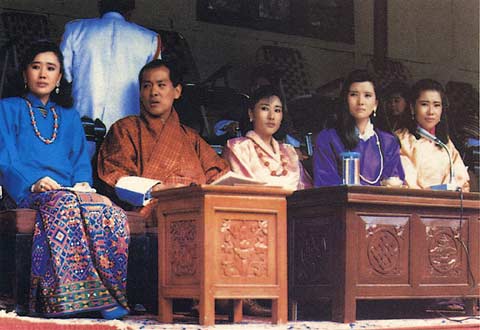Bhutan and ethnic Nepalese:
An identity under crisis, yet a struggle ahead
-A critical analysis by Dr. Lakshmi Prasad Dhakal
Bhutan is inhabited by a heterogeneous group of people; their root of origin being Tibet, Burma, India and Nepal. Only a very small section of the population is indigenous. In 1907, Ugyen Wangchuk consolidated power following his victory over the battle of Changlimithang thereby ending the rule of Dev Rajas. He then proclaimed himself as the first king of unified Bhutan. The monarchy established since then was administratively dominated by the Ngalongs, the ruling ethnic group. The 3rd king, Jigme Dorji Wangchuk, however revised the policies giving more space for inclusion, participation and recognition of other ethnic groups in issues of national interest. This provision was slowly and progressively withdrawn by the fourth king, Jigme Singye Wangchuk.
During the reign of the 4th king, in 1970s and 1980s, a series of repressive citizenship laws and "Bhutanisation"; policies were introduced. These policies deliberately excluded the ethnic Nepalese living along the southern belt of the country from all the political, economic, and cultural agendas (Mathew, 1999). This applies true to the Sharchops, predominantly living along the eastern part of the country.
Experts claim that the king and his courtiers perceived growing popularity of the ethnic Nepali population and their economic betterment, especially in the southern districts a threat to Drukpa culture and the then political dogma. As a result, violating the international human rights laws, the government enforced 1958 Citizenship Act retrospectively. Through the 1988 census (that enforced 1958 Citizenship Act in retrospective manner), the regime disowned thousands of Lhotshampas (people living in south) of Nepali origin (United Nations, 2008) . Subsequently, "one nation, one people" policy was introduced in 1989 enforcing obligatory Buddhist religion, a dress code, culture and language through out the country (Amnesty International, 1992; 1994). Defiance to the policy resulted in detention and fine of 3.3 dollars per episode (BBC, 1998) .
In the early 1990s, Lhotsampas demonstrated their discontent to these policies through peaceful demonstrations organised in all the southern districts. The Bhutanese government crushed the demonstration through martial law (Dhakal & Strawn, 1994). Royal Bhutan Police and Royal Bhutan Army arrested,
imprisoned, tortured, terrorised and raped people who were involved in the demonstration and those suspected to have extended moral support (Human Rights Watch, 2003). Subsequently, schools in the southern districts were shut down and health services suspended. Government forces demolished houses and forced many ethnic Nepalese off their lands (Amnesty International, & Piper).
This led people of Nepali origin to flee their country for safety to India and subsequently to Nepal during early 1990s. More than 120000 Bhutanese then got registered as asylum-seekers in United Nations High Commissioner for Refugees (UNHCR) managed refugee camps in Nepal.
To take these people back home, several rounds of Nepal-Bhutan ministerial level meetings were organised. The process ended with a dead-lock in 2003 (Amnesty International, 2004).
This led the international community to label Bhutanese refugees as the forgotten people and a humanitarian tragedy (CDC, 2009) . So, the international community envisioned third country resettlement as the only option to the stalemate (UN, 2009) . The United States of America, Canada, Australia, Denmark, New Zealand and the Netherlands have expressed their generosity to solve this human tragedy.
This is how a tiny Himalayan kingdom known to the rest of world as a peaceful paradise, generated the largest refugees per capita and successfully expelled them forever from their country.
 |
Bhutan's concept of gross national happiness (GNH) therefore needs a critical analysis. Fig. 1 gives us the impression over Bhutan's GNH. Here is the then King, Jigme Singye Wangchuk with his 4 wives. His courtiers also with similar polygamy practice live with the tax paid by the hard-handed citizens. It is to these privileged ones, the concept of GNP applies when; poor are dying unable to meet their ends.
Saul (2000) made a strong argument - in its principles of GNH, Bhutan compares individual rights insignificant to collective rights. The differential democracy that Bhutan opts ignores basic standards of human rights and economic, social and cultural rights. He raised concerns if this place to civil and political rights is inline to international humanitarian laws.
But, the resettled people are happy and grateful to those countries that have chosen to adopt them. Though there are numerous challenges in their new home countries; their lives are changing, opportunities are building up and everything is moving. Taking in account the cruel and wicked act of Bhutanese regime, probably, very few if at all any, may chose to go back to Bhutan; even if the Bhutanese regime would invite them back. Though it is hard to accept to disown the country of my birth, I have made up my mind. Despite this, whatever the experts claim, however generous the resettlement program is, whatever service and comfort is given to us, however far we can excel; I ask myself
1. If the international community has done a justice to us? If it has played a fair game? Did we deserve expulsion? If not, did the world do enough? Didn't we have rights to get back to our homes?
2. Though a durable solution, is this a treatment of the cause
or treatment of the symptoms? Won't this promote next
phases of expulsions? What lessons should other countries
learn from this? Shall this not lead to expulsion of more
minority groups?
References: